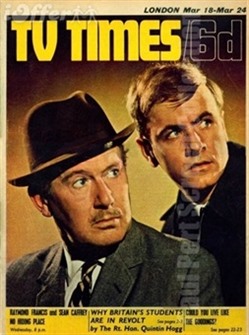
The Royal Mint is the United Kingdom's official maker of British coins. It is currently located in Llantrisant, Wales, where it moved in 1968.

Francis William Thring IV was an Australian character actor in radio, stage, television and film; as well as a theatre director. His early career started in London in theatre productions, before he starred in Hollywood film, where he became best known for roles in Ben-Hur in 1959 and King of Kings in 1961. He was known for always wearing black and styling his home in black decor.
Stingers is an Australian police procedural crime drama television series. It premiered on 29 September 1998, and ran for eight seasons on the Nine Network before it was cancelled in late 2004 due to declining ratings, with its final episode airing on 14 December 2004. Inspired by true events, Stingers chronicled the cases of a deep undercover unit of the Victoria Police. The series also followed their personal lives, which sometimes became intertwined with their jobs. The original cast members include Peter Phelps, Joe Petruzzi, Kate Kendall, Ian Stenlake, Anita Hegh, and Jessica Napier. Phelps and Kendall were the only actors to remain with the show for its entire run.

Gary Sweet is an Australian film and television actor known for his roles in Alexandra's Project, Police Rescue, Cody, Big Sky, Bodyline, Stingers and House Husbands.
Water Rats is an Australian TV police procedural broadcast on the Nine Network from 1996 to 2001. The series was based on the work of Sydney Water Police who fight crime around Sydney Harbour and surrounding locales. The show was set on and around Goat Island in Sydney Harbour.
Cop Shop is a long-running Australian police drama television series produced by Crawford Productions that ran for seven seasons between 28 November 1977 and 23 July 1984. It comprised 582 one-hour episodes.

The Perth Mint Swindle is the popular name for the robbery of 49 gold bars weighing 69 kilograms from the Perth Mint in Western Australia on 22 June 1982. The bullion was valued at A$653,000 at that time. As of August 2023, the value of 68 kilograms (150 lb) of gold would be in excess of A$6.4 million. According to police at the time, three brothers—Ray, Peter, and Brian Mickelberg—orchestrated the robbery. The three went to trial and were found guilty of the conspiracy and sentenced in 1983 to twenty, sixteen and twelve years in jail, respectively.

The Perth Mint is Australia's official bullion mint and wholly owned by the Government of Western Australia. Established on 20 June 1899, two years before Australia's Federation in 1901, the Perth Mint was the last of three Australian colonial branches of the United Kingdom's Royal Mint intended to refine gold from the gold rushes and to mint gold sovereigns and half-sovereigns for the British Empire. Along with the Royal Australian Mint, which produces coins of the Australian dollar for circulation, the Perth Mint is the older of Australia's two mints issuing coins that are legal tender.
Rafferty's Rules is an Australian television drama series which ran from 1987 to 1991 on the Seven Network.

No Hiding Place is a British television series that was produced at Wembley Studios by Associated-Rediffusion for the ITV network between 16 September 1959 and 22 June 1967.
Rush is an Australian television series produced by the Australian Broadcasting Corporation between 1974 and 1976. The first 13 episodes were produced in 1974 and filmed in black and white. In 1976, 13 more episodes were produced, in colour, in conjunction with French public broadcaster Antenne 2. Each series featured a different cast with the exception of John Waters.

Russell Gordon Napier was an Australian actor.

Todd James Lasance is an Australian actor, best recognised for his roles in Australian television including Aden Jefferies on Home and Away, Cam Jackson on Rescue: Special Ops, Ben McMahon on Crownies and Major Sydney "Syd" Cook on ANZAC Girls. He has also appeared in American television roles, such as Julius Caesar on Spartacus: War of the Damned, Julian on The Vampire Diaries and Edward Clariss / Rival on The Flash. In 2020, he partnered with his Spartacus co-star Liam McIntyre to create the gaming series Get Good for the CouchSoup YouTube channel, following a charity livestream benefiting Black Summer.
Caroline McKenzie is an Australian stage and screen actress. She is a member of the theatre and dance faculty at the Western Australian Academy of Performing Arts at Edith Cowan University.

John David Batchelor is a Singaporean-born Australian television and film actor. He is most known for portraying Chief Petty Officer Marine Technical (CPOMT) / Chief Engineer Andy 'Charge' Thorpe on the Australian drama series Sea Patrol, and Peeto in the Australian feature film Red Dog.

Antonio De Paulo "Tony" Buti is an Australian politician. He has been a Labor Party member of the Western Australian Legislative Assembly representing the seat of Armadale since 2 October 2010, when he was elected in a by-election.
Ben Hall is a 1975 Australian TV series based on the bush ranger Ben Hall. It stars Jon Finch as Ben Hall, Evin Crowley as Biddy Hall, John Castle as bushranger Frank Gardiner, Brian Blain as Sir Frederick Pottinger, Jack Charles as Billy Dargin and John Orcsik as John Gilbert. Neil McCallum was the creator-producer and the series editor was Colin Free.

The Great Mint Swindle is a 2012 Australian television film directed by Geoff Bennett and starring Grant Bowler, Todd Lasance and Josh Quong Tart. It is based on the Perth Mint Swindle which took place in the 1980s.
Avon Lovell is a Western Australian investigative journalist and writer who wrote books about the Perth Mint Swindle, including The Mickelberg Stitch.
Robin William Kermode, is an English actor, author and communications coach. He is best known for his role in Never the Twain, Ffizz, The Ruth Rendell Mysteries, Iron Lady, Wilde, the Norman Conquests, She Stoops to Conquer and Blithe Spirit.









